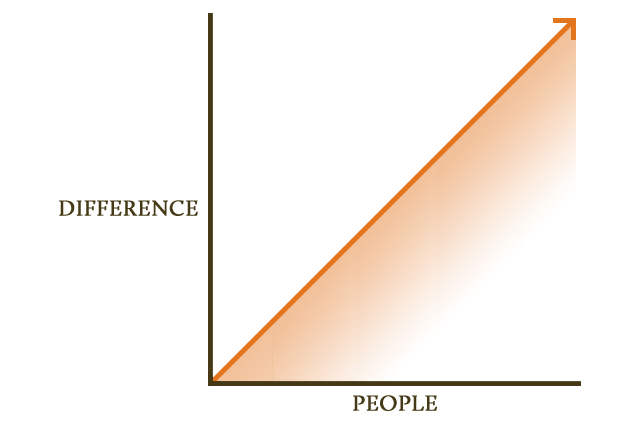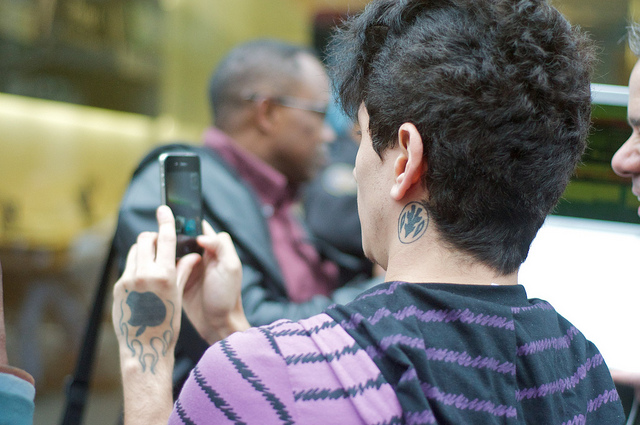Unlock the Magic in Your Story Now
Get the Free 20 questions to Ask Before Launching Your Idea workbook when you sign up for occasional updates.
Get the Free 20 questions to Ask Before Launching Your Idea workbook when you sign up for occasional updates.
Articles filed in: Strategy
Winning In The Difference Economy
 I’m not sure what department stores look like on a Tuesday afternoon in your neighbourhood, but in mine they are like ghost towns. Whole floors full of stock that changes with the seasons waiting to be bought by someone (they don’t know who), who happens to stop by. We all know the stories of the Davids beating Goliaths in the marketplace over the past decade—Borders losing out to Amazon and Blockbuster dying because of Netflix are just two examples.
I’m not sure what department stores look like on a Tuesday afternoon in your neighbourhood, but in mine they are like ghost towns. Whole floors full of stock that changes with the seasons waiting to be bought by someone (they don’t know who), who happens to stop by. We all know the stories of the Davids beating Goliaths in the marketplace over the past decade—Borders losing out to Amazon and Blockbuster dying because of Netflix are just two examples.
Ask any business analyst why this happened and you’ll get a variety of answers. These companies were too slow to respond to shifts in the market, they didn’t embrace digital quickly enough, or they had too many layers of bureaucracy. What this all boils down to is two things.
1. They didn’t meet their customers where they were.
2. They were so focused on operating in the present, that they didn’t see where their customers might be in both the near and distant future.
If we look at some of the runaway business success stories of our time Dropbox, Uber, Warby Parker, Airbnb, Apple, Starbucks and Patagonia we find that they all have something in common. They knew who their customers were or would be and they built their businesses around being responsive to them. Their continued success is powered not by sales teams and marketing departments, but by creating difference for people, one person at a time.
The bigger the difference they create, even in the tiniest niche, the more (not the most) people they touch, the more successful they become.
The businesses that are winning in the difference economy are the ones that impact people on a personal level by staying relevant, they also shape culture by being responsive to the changes that a digital world has enabled.
The difference economy values and rewards businesses that put customer’s needs, wants and unexpressed desires first. Businesses that are built to respond to those needs, not simply to react to changing seasons and upcoming holiday periods. From coffee to computers, travel to data storage, the brands that succeed wildly are the ones that work hardest of all to see their customers before they build a thing.
We Need To Stop Telling Customers What We Do
filed in Marketing, Storytelling, Strategy
 I’m driving along behind the white Ezy Tiles van, when we stop at a red light and I get close enough to read their sales pitch, which is an image and a single line.
I’m driving along behind the white Ezy Tiles van, when we stop at a red light and I get close enough to read their sales pitch, which is an image and a single line.
The picture is of three guys wearing dust masks that look like something you’d see in a documentary about chemical warfare. Each one is brandishing some kind of heavy duty drill that it seems could demolish a room in minutes. The dust cloud that surrounds them obliterates the view of the river from the balcony in the background.
“We remove tiles and floors,” the tagline on the white van shouts at me.
“No you don’t,” I can’t help thinking.
“You come into my home and leave a trail of dust and destruction in your wake.”
While I might need old tiles to be removed, what I really want is a smooth, level surface to lay my gorgeous new tiles on.
It goes without saying that your process needs to delight customers every step of the way.
But your customers don’t want to know what you do. They want to know how you’re going to enable them to do what they want to do.
There’s a reason IKEA leaves the instructions and the confusing assortment of screws inside the packaging.
People almost never buy the process. They buy the result.
We really should be selling them what they want to be sold.
Image by Marcus Linder.
The Truth About Starbucks And The $4 Coffee
filed in Marketing, Storytelling, Strategy
 Before Starbucks you could buy your morning coffee for a dollar or two.
Before Starbucks you could buy your morning coffee for a dollar or two.
So how was it possible for Starbucks to more than double the price of coffee overnight?
The truth is that Starbucks didn’t actually invent the $4 coffee—they created the $2 experience.
$2 felt like a bargain for the feeling of belonging in a comfy chair at ‘the third place’.
A place we now feel a connection to at the sight of a single green straw, even when we’re not in it.
And a place we didn’t even know we wanted until Starbucks showed us that we clearly did.
As a marketer your job is not to convince people that your product or service is better and therefore worth more. Your job is to find, understand and serve the people who are ready to believe a different story about where the value really lies.
Image by Bart Heird.
The Limitations Of Knowing ‘How To’
filed in Storytelling, Strategy
 For years we’ve been rewarded for knowing the right answer. All of those gummed gold stars licked and stuck in copybooks next to neatly spaced handwriting, served their purpose.
For years we’ve been rewarded for knowing the right answer. All of those gummed gold stars licked and stuck in copybooks next to neatly spaced handwriting, served their purpose.
We can’t help wanting to know the answer.
Knowing ‘how to’ is barely an advantage to the twenty first century business owner or entrepreneur, because there is no one right answer. There is no one way to get to where you want to go—and that’s a great thing! If there was a ‘how to’ guide then everyone would have the formula and nothing we created would be unique.
Nobody told Jobs and Wozniak how to build a computer company, let alone how to make it one of the most loved brands in the world, and Howard Schultz didn’t get the Starbucks magic from a manual.
Nobody can tell you what to stand for, or how your values, wants and needs, should intersect with those of your customers and then manifest as a business, an idea or experience. Figuring out the destination is hard—but recognising it, is more valuable than knowing exactly how you’re going to get there. Until you do the hard work of understanding the ‘why’ and the ‘who for’ every tactical ‘how to’ has the potential to take you down the wrong track.
The most useful answers are the ones we take time to figure out for ourselves—not the ones that everyone can find in a handbook.
It turns out that it’s more powerful to have your own map than it is to have someone else’s directions. Once you have that map, you’ll always have a way to get from where you are to where you want to go.
Image by Caroline Jung.
Great Content Marketing Doesn’t Feel Like Marketing.

“You have more chance of summiting
Mount Everest than getting someone
to click on a banner ad.”
—Jonathan Perelman
VP at Buzzfeed
Getting the word out about your products and services can feel a bit like an Everest expedition.
You and I know that traditional advertising doesn’t work anymore. We’ve known from as far back as 2005 that the return on investment from advertising could be as little as 4%. Then along came a new marketing ‘secret sauce’, a way to attract customers and gain their loyalty—all we had to do was create content.
It’s tempting to think that we can use content in the way that we once used traditional advertising to attract the most people. The best content though, goes beyond simply being advertorial and appealing to everyone. Why do you return to your favourite blogs? What makes you share the content you choose to share?
The Secrets of great content marketing
1. Great content changes how people feel by being either useful, entertaining or inspiring.
Think about how you want your readers to feel as they read the last line of your article.
What do you want them to do next? That doesn’t mean getting them to click on a ‘BUY NOW’ link every time.
2. Your products and services help clients and customers to be better versions of themselves every day, your content should be designed to do that too.
Building trust and connection to you and your brand over time, rather than promotion, is the point. Great content doesn’t feel like marketing—it feels like a gift.
3. Just as your marketing isn’t something that’s separate from the work that you do, content marketing should be an extension of it too.
Authentically bake it into your business, don’t just slap it on as an afterthought to fill white space and create noise. Use content to help people to understand more about who you are and what your business stands for.
4. Don’t see your content as a big old sales funnel.
Treat it more like a flame, a campfire that people want to come back to. Intention is everything. People can sense yours, they know when you’re in it for the right reasons.
5. Practice patience.
The reason we got into this fix was by trying to take the shortcut to mattering to our customers. An advert that could blast hundreds of thousands of people felt like a bargain. It turns out it was a Trojan horse that destroyed our relationships with our customers. The people, brands and businesses that have the traction you’re craving have been creating content and providing value to their audiences for years. There’s nothing to stop you doing that too.
Plant your flag. Bring people with you.
Image by Brigitte Djajasasmita.
How To Sell A Guitar…..Or Anything
 The number one reason a salesperson fails to close a sale is that she can’t effectively communicate the value of the product. Of course it makes sense that if you can’t help your customers to understand why they should care, then you’re not likely to be able to convince them to buy.
The number one reason a salesperson fails to close a sale is that she can’t effectively communicate the value of the product. Of course it makes sense that if you can’t help your customers to understand why they should care, then you’re not likely to be able to convince them to buy.
The luthier takes care to choose the perfect piece of wood. She obsesses about the distance between frets and the quality of the strings she uses. But she often forgets to spend time wondering how to tell the customer why any of that should matter to him.
A winning sales strategy doesn’t just involve working out how to sell more of what you make.
A better plan is to understand what people really value and then to give them exactly that.
Don’t sell the guitar. Sell the music.
Image by Fr1zz.
5 Reasons Microsoft Failed To Compete In A Post iPhone World
 Soon after Apple launched the iPhone in 2007, Microsoft’s then CEO Steve Balmer gave this short video interview. In two minutes he shed light on Microsoft’s business strategy which gives us some clues as to why Apple would dominate over the next seven years.
Soon after Apple launched the iPhone in 2007, Microsoft’s then CEO Steve Balmer gave this short video interview. In two minutes he shed light on Microsoft’s business strategy which gives us some clues as to why Apple would dominate over the next seven years.
5 Strategic Mistakes Microsoft Made Post iPhone
1. Competing on price.
Steve Balmer’s opening shot signalled that Microsoft were competing on price and not thinking of other ways to add value. Just because you’re cheaper doesn’t mean you’re going appeal to more of the right people.
2. Failing to see the future and misjudging the target market for smart phones.
The leadership team at Microsoft didn’t seem to understand that one day soon, everyone—not just ‘business customers’ would want to access email and the Internet from their phone.
3. Leading with the product’s features and benefits.
Balmer talks exclusively about what Microsoft’s phones will do.
Apple always, always, always, focuses on what their products will enable people to do.
The keyboard which Balmer describes as an advantage was one of the things Steve Jobs highlighted as a disadvantage of traditional smartphones.
4. Focusing on market share before heart share.
Microsoft were ‘selling millions and millions and millions of phones a year’, Apple was selling zero. Of course we all know how rapidly that changed. Within 8 months the iPhone captured 28% of the market, because their strategy has always been to gain share of heart first.
5. Having a reactive business strategy.
Creating products and innovations from a place of fear, (you can see it in his eyes) and focusing more on beating the competition than on what would make their customers’ lives better.
How could you avoid making similar mistakes in your business?
Image by Steve Rhodes.
 The middle-aged couple at the garden centre stood with furrowed brows as the sales assistant explained the difference between the varieties of lemon tree. They took a step back and almost looked alarmed when he explained how one particular variety would bear a lot of fruit, but could become tall, straggly and unmanageable. Huge smiles of relief spread across their faces when he finally led them to a tree that would give them less fruit, but only grow to about a metre tall.
The middle-aged couple at the garden centre stood with furrowed brows as the sales assistant explained the difference between the varieties of lemon tree. They took a step back and almost looked alarmed when he explained how one particular variety would bear a lot of fruit, but could become tall, straggly and unmanageable. Huge smiles of relief spread across their faces when he finally led them to a tree that would give them less fruit, but only grow to about a metre tall.  Picture the scene. A group of five girlfriends are out celebrating a birthday together. The evening is drawing to a close, dinner plates have been cleared and the last bottle of red has been emptied.
Picture the scene. A group of five girlfriends are out celebrating a birthday together. The evening is drawing to a close, dinner plates have been cleared and the last bottle of red has been emptied.
March 12, 2014
Blog Comments: Strategy Or Tactic?
filed in Strategy
When people began blogging over a decade ago blog comments were a real way to engage or add to the discussion. Today the amount of content we can access online has exploded and how we consume that content on the go via mobile devices has changed things. The truth is that a tiny percentage of readers ever leave a comment and some of the most popular single author blogs in the world like Zen Habits don’t have comments at all.
Here are a few things I’ve noticed about blog comments
The number of comments is seen as social proof, or as a way to judge the worthiness of a post.
We assume that if a post is good it will have lots of comments. But a post that might resonate with you may not appeal to someone who likes to comment. Many of the most shared posts on this blog have no comments. I noticed that this bothered my loyal readers who felt the need to comment just to say thanks for writing an article that helped them.
Many blog posts are engineered to invite comments.
Often blog posts end with a question. Sometimes that question adds value, but more often it’s used as a tactic to get more comments.
Older blogs have built communities through comments.
Established blogs became places where readers recongised and connected with the ideas of other readers through comments. That’s getting harder to do these days.
Readers use comments to acknowledge and connect with the writer.
That can be a good thing, but there are better ways for you and I to meaningfully connect.
Readers use comments to show their gratitude.
I love the intention behind that—but there are limits to how many times someone can say, ‘thanks for writing this post, here’s how it helped me.’ in the comments.
I don’t want people to dismiss a post that might be useful to them because it has no comments. I want to empower readers to decide what’s relevant to them. I’m not sure that comments are the best way to make either better writers, or more informed and inspired readers.
I want to spend time writing for you and not trying to massage the end of each post with a question that’s designed to make you comment so that I can show the world that a gazillion people read it. I am happy if each post helps a handful of people to go out there and bring ideas that create difference to the world.
If I am going to build a community around these ideas I believe I need to do that with intention and right now comments are not helping me to do that.
I don’t want you to comment because you feel like you should, or because you feel like you need to pay me back in comments. You’ve already paid with your time, attention and trust. I don’t take any of that for granted for a second.
If you ever want to reach out to me to say anything—even if it’s thanks, you can contact me any time, as many readers do by hitting reply when posts are emailed to you or by email.
So, that’s my very long winded way of explaining why I’ve decided to switch off comments here for now to see how we go. This is not to say that comments won’t work brilliantly for you and your blog.
Today might be the end of comments, but it’s definitely not the end of the conversation.
Image by Eddie Codel.